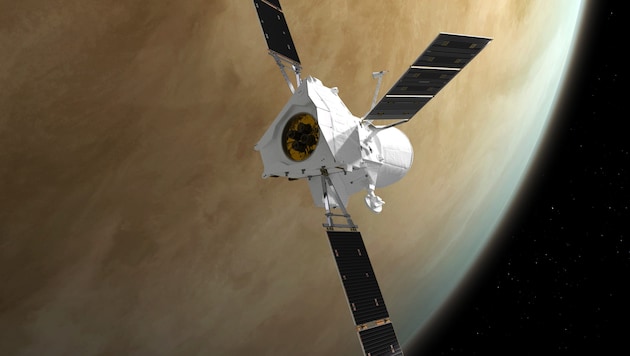BepiColombo" mission
Carbon and oxygen found around Venus
On the way to its actual destination, the planet Mercury, the European-Japanese space probe "BepiColombo" has also collected data from the vicinity of Venus. For the first time, it has been proven that our neighboring planet loses particles of carbon and oxygen into space.
This provides new insights into the development and composition of planetary atmospheres, the Austrian Academy of Sciences (ÖAW) announced on Friday. The measuring instruments with which the discovery was made were co-developed by the Institute of Space Research (IWF) in Graz.
Venus has no magnetic field of its own
Unlike the Earth, Venus has no magnetic field of its own to provide protection against solar wind. The stream of particles emanating from the sun therefore accelerates ions - electrically charged atoms - in the planet's atmosphere. The ions thus reach outer space.
Previous measurements had already established that the particles consist largely of oxygen and hydrogen. A more precise distinction between oxygen, carbon and nitrogen has only now been possible, the IWF wrote in a press release on Friday. The measurements by "BepiColombo" were taken on 10 August 2021 around 550 kilometers from the surface of Venus. The findings have now been published in the journal "Nature Astronomy".
Measuring instruments co-developed by the IWF in Graz
The IWF is involved in the magnetic field measuring instruments and the ion spectrometer used in the "BepiColombo" mission. "It's great that the years of intensive work are already bearing fruit before 'BepiColombo' has even reached its destination," said researcher and co-author David Fischer in the press release.
For IWF Director Christiane Helling, the measurements on Venus could provide more information about the atmosphere and magnetosphere around planets as well as the interaction with the solar wind. Electrons are released from Venus, creating an electric field. This probably ejects the carbon and oxygen ions from its atmosphere.
Collaboration between ESA and JAXA
"BepiColombo" is a twin space probe developed in collaboration between the European Space Agency (ESA) and the Japanese Space Agency (JAXA). It was launched on October 20, 2018 and is scheduled to reach its destination Mercury at the end of 2025. On its journey, it will orbit Earth, Venus and Mercury several times in order to counter the strong gravitational pull of the sun.
"BepiColombo" will study the magnetic field around Mercury and the influence of the solar winds. The researchers hope to gain insights into the inner structure of the planet. Ultimately, this should also help to better understand the core of our planet.











Kommentare
Willkommen in unserer Community! Eingehende Beiträge werden geprüft und anschließend veröffentlicht. Bitte achten Sie auf Einhaltung unserer Netiquette und AGB. Für ausführliche Diskussionen steht Ihnen ebenso das krone.at-Forum zur Verfügung. Hier können Sie das Community-Team via unserer Melde- und Abhilfestelle kontaktieren.
User-Beiträge geben nicht notwendigerweise die Meinung des Betreibers/der Redaktion bzw. von Krone Multimedia (KMM) wieder. In diesem Sinne distanziert sich die Redaktion/der Betreiber von den Inhalten in diesem Diskussionsforum. KMM behält sich insbesondere vor, gegen geltendes Recht verstoßende, den guten Sitten oder der Netiquette widersprechende bzw. dem Ansehen von KMM zuwiderlaufende Beiträge zu löschen, diesbezüglichen Schadenersatz gegenüber dem betreffenden User geltend zu machen, die Nutzer-Daten zu Zwecken der Rechtsverfolgung zu verwenden und strafrechtlich relevante Beiträge zur Anzeige zu bringen (siehe auch AGB). Hier können Sie das Community-Team via unserer Melde- und Abhilfestelle kontaktieren.